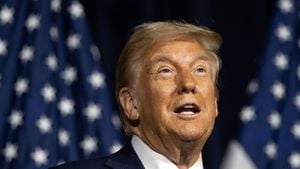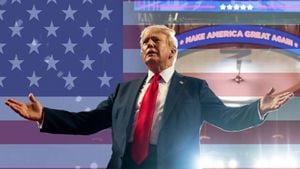With Donald Trump retaking the presidency, American consumers are bracing for significant changes to their wallets. One of the hallmarks of his administration's economic strategy is the proposed tariffs on imported goods, particularly those from China, which could turn the already complicated economic waters even murkier. While Trump contends this economic approach will benefit American manufacturing by compelling companies to produce domestically, experts forecast dire consequences for ordinary consumers, such as skyrocketing prices.
During his campaign, Trump promised steep tariffs of up to 100% on certain Chinese goods and between 10% and 20% on products from other countries. These rates harken back to trade policies not seen since the 1800s. It’s worth noting, these measures have the potential to increase the cost of everyday items significantly. According to the National Retail Federation (NRF), these proposals could result in annual price increases ranging from $46 billion to $78 billion across various consumer goods.
For those keeping score, Americans may see the price of essentials rise by as much as 20% on certain items. For example, the typical cost for products like running shoes could jump from $50 to nearly $64, and the price of electronics, such as laptops or toasters, could see similar increases. Ironically, just when inflation had begun to moderate, this shift could quickly shift things back toward increased living costs.
At the core of Trump's tariff strategy is the belief it will push American companies to manufacture goods locally rather than relying on cheaper imports. Yet, economic observers warn the reality may differ. The burden of these tariffs will fall not on foreign manufacturers but directly on American consumers and businesses. “Tariffs represent taxes placed on imported goods by the U.S. government, and those costs will likely be passed on to consumers,” said Jonathan Gold, NRF Vice President. This means prices will inflate, affecting household budgets just as families were beginning to feel relief from previous inflation spikes.
“Retailers rely heavily on imported products,” Gold continued. “If tariffs are implemented, they must choose between absorbing those costs or passing them along to consumers, leading to price hikes on everyday goods.” The NRF estimates the increase could hit around $7,000 per household yearly.
With retailers like American Eagle and Five Below sourcing 20% or more of their products from China, they are particularly vulnerable to these impending costs. For these businesses, maintaining competitive prices will be increasingly difficult, potentially forcing them to shrink their profit margins or, quite simply, hike prices on consumers, who are already grappling with inflationary pressures. Five Below, for example, has reportedly already faced downgrades from analysts, pointing to its limited pricing power to absorb these potential tariffs.
Even companies producing household staples are bracing for the financial impact. The CEO of e.l.f. Beauty indicated they could be forced to increase prices depending on the enormity of the tariffs. “We do have pricing power. If we saw we needed to leverage pricing, we would,” said e.l.f. CEO Tarang Amin. This sentiment resonates across various sectors, with the retail industry expressing concern over the imminent financial stress these tariffs will bring.
Meanwhile, the American Association of Port Authorities acknowledged the changes expected to flow from new tariffs. They expressed eagerness to collaborate with the new administration to improve infrastructure and readiness for anticipated retail slowdowns.
Analysts predict the market reaction will witness retailers stockpiling goods to avoid the brunt of rising costs, leading to increased freight volumes as well. During Trump's previous administration, similar tariffs led to freight rates skyrocketing by 70%, resulting from businesses scrambling to import goods before price hikes took effect.
"The knee-jerk reaction from U.S. shippers will be to frontload imports before Trump is able to impose his new tariffs. If you have the warehouse space and can ship goods, frontloading imports minimizes your risk temporarily," said Peter Sand, analyst at Xeneta.
While companies might initially turn to raising consumer prices to offset costs, longer-term adjustments could eventually stabilize the market, but only after considerable upheaval and distress for both businesses and shoppers alike.
The debate around tariffs often centers on whether changing trade policies can truly revitalize the domestic manufacturing sector. Critics argue there are more practical ways to boost job creation without burdening consumers. Studies suggest shifting production to nations with lower costs will likely remain more appealing than relocating back to the U.S. simply due to conventional economic factors like overhead costs.
The anticipated tariffs have ignited discussions among political and economic circles about their broader impacts on U.S. supply chains, trade relations, and, most critically, consumers who might face unavoidable price increases on goods just when they thought relief was on the horizon. Between anxiously watching the market and keeping sharp tabs on prices, American consumers can expect the start of Trump's new term to have significant repercussions on their buying experience.
Economists have raised awareness of how stabilizing the market and counteracting inflation could turn out to be counterproductive if new tariffs come crashing down just as consumers breathe a sigh of relief. Tariffs, they argue, do not operate as foreign punishment for corporate practices but rather as burdens impacting the financial realities of everyday activities: filling shopping carts and relying on affordable prices on needed goods.
The path forward is deeply intertwined with the administration’s approach to these trade policies and their broader economic implications. Retailers may maneuver their strategies, consumers will adjust to the pressures of increased prices, and economists will continue to analyze the shifting trends until the dust settles on how Trump's proposals play out on American households and the economy overall.



